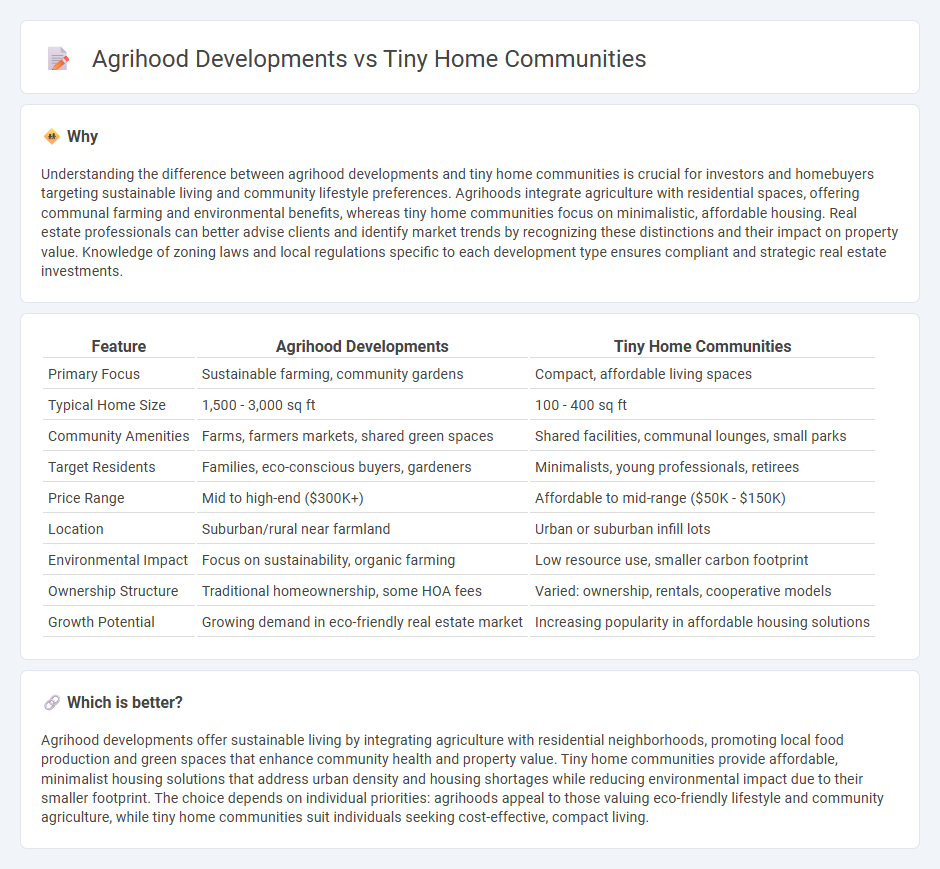
Agrihood developments integrate sustainable farming and residential living, fostering a community centered around shared agricultural spaces and fresh, locally grown food. Tiny home communities prioritize compact, efficient living with affordable, low-impact housing designed to maximize space and minimize costs. Explore the benefits and unique features of these innovative residential concepts to find the best fit for your lifestyle.
Why it is important
Understanding the difference between agrihood developments and tiny home communities is crucial for investors and homebuyers targeting sustainable living and community lifestyle preferences. Agrihoods integrate agriculture with residential spaces, offering communal farming and environmental benefits, whereas tiny home communities focus on minimalistic, affordable housing. Real estate professionals can better advise clients and identify market trends by recognizing these distinctions and their impact on property value. Knowledge of zoning laws and local regulations specific to each development type ensures compliant and strategic real estate investments.
Comparison Table
| Feature | Agrihood Developments | Tiny Home Communities |
|---|---|---|
| Primary Focus | Sustainable farming, community gardens | Compact, affordable living spaces |
| Typical Home Size | 1,500 - 3,000 sq ft | 100 - 400 sq ft |
| Community Amenities | Farms, farmers markets, shared green spaces | Shared facilities, communal lounges, small parks |
| Target Residents | Families, eco-conscious buyers, gardeners | Minimalists, young professionals, retirees |
| Price Range | Mid to high-end ($300K+) | Affordable to mid-range ($50K - $150K) |
| Location | Suburban/rural near farmland | Urban or suburban infill lots |
| Environmental Impact | Focus on sustainability, organic farming | Low resource use, smaller carbon footprint |
| Ownership Structure | Traditional homeownership, some HOA fees | Varied: ownership, rentals, cooperative models |
| Growth Potential | Growing demand in eco-friendly real estate market | Increasing popularity in affordable housing solutions |
Which is better?
Agrihood developments offer sustainable living by integrating agriculture with residential neighborhoods, promoting local food production and green spaces that enhance community health and property value. Tiny home communities provide affordable, minimalist housing solutions that address urban density and housing shortages while reducing environmental impact due to their smaller footprint. The choice depends on individual priorities: agrihoods appeal to those valuing eco-friendly lifestyle and community agriculture, while tiny home communities suit individuals seeking cost-effective, compact living.
Connection
Agrihood developments and tiny home communities intersect through their focus on sustainability and community-centered living. Both prioritize efficient land use, integrating agricultural spaces or communal gardens with compact, affordable housing to promote eco-friendly lifestyles and social interaction. This fusion supports local food production while addressing housing affordability challenges.
Key Terms
**Tiny Home Communities:**
Tiny home communities offer compact, affordable living spaces designed to maximize land use efficiency and foster close-knit neighborhoods. These communities emphasize sustainable living, including energy-efficient designs and shared amenities, appealing to eco-conscious residents seeking minimalistic lifestyles. Explore more about how tiny home communities reshape affordable housing and community engagement.
Zoning Regulations
Tiny home communities often face more flexible zoning regulations due to their smaller footprint and potential for affordability; however, many municipalities still lack clear guidelines specifically tailored to these developments. Agrihood developments, integrating residential areas with working farms, encounter complex zoning due to agricultural land preservation and residential use conflicts, requiring careful navigation of both urban planning and agricultural regulations. Explore further to understand how evolving zoning codes impact the growth and sustainability of these innovative living models.
Shared Amenities
Tiny home communities often emphasize shared amenities like communal kitchens, co-working spaces, and recreational areas designed to foster social interaction and efficient land use. Agrihood developments integrate communal farms, gardens, and farmers' markets as central shared amenities, promoting sustainable living and local food production. Discover how these distinct shared amenities impact community lifestyle and sustainability in detail.
Source and External Links
Top 11 Tiny Home Communities in California (Must-see) - California hosts notable tiny home communities like Tiny House Block focused on sustainability, Lemon Cove Village offering family-friendly outdoor activities, and Palm Canyon Mobile Club delivering luxury tiny homes, plus communities catering to seniors and urban-rural blends.
Discover Tiny Home Communities In The USA - Across the U.S., tiny home communities vary from Hope Village, a supportive housing project for the homeless in Illinois, to Lake Dallas Tiny Home Village in Texas featuring city-limit legal homes, and County Line Cottages, a 55+ community in rural Texas with extensive amenities.
Tiny House Communities - Escalante Village in Durango, Colorado, is a pioneering tiny home community offering riverfront living, affordable ownership, personalized design options, and community amenities close to outdoor recreation.
 dowidth.com
dowidth.com